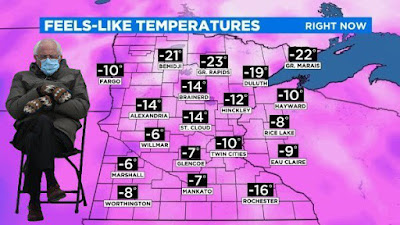 |
| Sunday evening's snow forecast from the National Weather Service office in South Burlington. Yellow areas can expect six inches of more. Orange areas get eight inches or more. |
The overall forecast from this morning really hasn't changed all that much. That's a bit remarkable, given the complexity of the storm. But both computer models and human meteorologists keep getting better and better at this game. So there you go.
Today was a classic, beautiful winter's day in Vermont, wasn't it? Yeah, it was chilly, but the sun was out and the winds were light. I hope you had a chance to get outdoors to enjoy that bracing winter air.
Tonight will be cold again but maybe not as cold as last night, given those high clouds from the storm starting to stream in. Very slowly.
You'd think that with snow just starting in New York City in the 5 p.m. hour today, it would get up here to Vermont by morning.
But dry, cold air is holding tough over us, and it's taking time for the next phase of the storm to take shape.
We'll actually have a fair amount of filtered sun through high clouds on Monday in Vermont. Be on the lookout for a ring around the sun during the day Monday which is so often a sign of an impending snowfall around here.
Sure enough, the storm will get its act together and finally send a relatively sharp warm front of sorts towards us Monday night and Tuesday.
Don't be afraid of the term "warm front" in this case. Usually a warm front spells mixed precipitation or even rain for us but not this time.
The sort of warm front will produce a band of lift in the atmosphere that will move southeast to northwest across Vermont late Monday night and Tuesday morning. That lift - rising air in the atmosphere - will encourage snow to blossom. Warmish air overriding cold air at the surface will contribute to the rate of precipitation.
 |
| Calm before the storm. Late afternoon sun Sunday on a snow and rime ice encrusted Mount Mansfield, Vermont. |
This will be the most "exciting" part of the storm for Vermont. By "exciting," it will still mean things will be more low key here than points south.
The excitement for us means a period of moderate to maybe at times heavy snow late Monday night and the first half of Tuesday. That's at least the way things look now.
Given the strong east to southeast winds, especially aloft, the eastern slopes of the Green Mountains, especially from about Killington south, will be the big winners with this initial burst.
Much of southern Vermont from White River Junction south seem like it will do pretty well, too. At least as the forecast stands now.
The eastern Adirondacks look good too. All these areas should expect a good 6 to 12 inches of snow from this initial burst, so winter storm warnings are up for these areas. Other parts of Vermont should receive two to six inches of snow. These areas are under less-dire winter weather advisories.
After this initial burst goes by, it still looks like northern areas will get most of the snow Tuesday afternoon, night and Wednesday morning. A few more inches will pile up there during this time. This even includes the Champlain Valley north of Burlington.
Areas east of the Green Mountains probably won't get much snow after Tuesday's burst. They'll be "shadowed" by the Green Mountains, so snowfall won't be impressive there starting Tuesday afternoon.
If you like snow, the biggest "loser" in this storm looks to be the upper Connecticut Valley from about Thetford to Lyndonville. During that initial burst of snow Tuesday morning, the White Mountains in New Hampshire will block the moisture, "shadowing" the area from a good thumping.
Then the second half of the storm will skip that area too.
All in all this looks like a middling size storm for Vermont. It's a complex thing, so the forecast could change one way or the other.
But this is looking like we will be bystanders to the real action further south.
EFFECTS SOUTH OF VERMONT
The governor of New Jersey has declared a state of emergency because of expected heavy snow and tidal flooding along the coast. That's a testament to how powerful the storm will be down there.
Snowfall rates in and around New York City could be two inches per hour Monday and Monday night, which is pretty impressive. This means they could get 18 inches of snow. High winds, gusting to 60 mph by the coast, will mean lots of blowing and drifting. The snow will also be fairly wet, leading to tree and power line damage.
Large areas of eastern Pennsylvania, eastern New York, southern and central New England, parts of Maine and New Hampshire should also clock in with a good foot and a half of snow.
Hundreds of vehicle crashes have already been reported in the Midwest and Mid-Atlantic States today.
Washington, DC, got nearly two inches of snow Sunday. That's not much, but it's the most they've had in nearly two years. "Violence" broke out on the National Mall in Washington as hundreds of people got involved in a good natured snow ball fight. So much better than storming the Capital, right?
The bottom line is that Vermont gets a typical, average winter storm, which we can deal with. Not so further south, I guess.




























